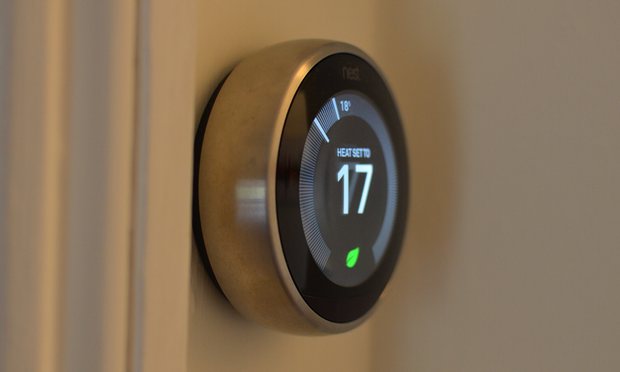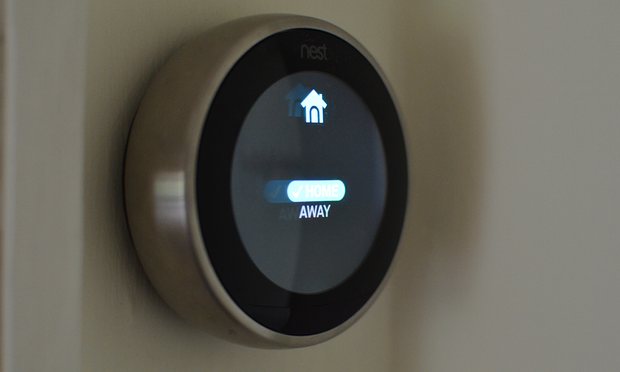
This article is more than
10 year oldhe new Nest learning thermostat is the third-generation heating control system f-rom Google owner Alphabet’s subsidiary. It is the second version to be released in the UK, and now comes with a bigger, clearer screen and more advanced components that not only work better, but also protect your boiler.
The UK version of the Nest is a thermostat that works like any other. Users configure the settings and the boiler fires up until it reaches the desired temperature.
The difference is that the Nest is smart – it learns your heating patterns, turns off the central heating when not needed and can work out how long it will take to heat your home to the desired temperature given the weather and the specifics of your house or flat.

The Nest Learning Thermostat isn’t the only smart heating controller on the market. They all perform a similar duty, adding learning, remote control and intelligence into the standard scheduling thermostat.
The new Nest looks very similar to the previous version. It is a round disk with a diameter of 8.4cm and a depth of 3.2cm that is either mounted to the wall or stuck in a tabletop stand. The outside metal ring rotates for se-lecting options and adjusting the temperature. The whole thing can be depressed as a giant se-lection button. Together they work very well, feeling intuitive with a good weight to them, like something mechanical and pleasing to use.
The screen is a big upgrade over the previous Nest: larger, brighter and crisper, which makes quite a difference when using it, as you typically stand quite close. A bottom black strip contains sensors that detect your movements in front of the thermostat as well as the available light and direct heat f-rom the Sun.

Setting up the Nest is pretty simple. Most will have a heating engineer attach the required Heat Link box to their boiler and the Nest to the wall in the desired spot.
It can be either wirelessly connected to the Heat Link and your boiler, or wired if you have an existing fixed thermostat. If connected wirelessly the thermostat needs a microUSB power adapter, which it comes with, but means it has to be relatively close to a plug socket. I bought a 3m microUSB cable and punched a small hole through the wall directly behind the thermostat to run power to it.
Once hooked up the thermostat is easy to control. It automatically learns your heating schedule over the next week – you can also manually schedule temperatures using the app or on the thermostat directly.
The screen remains off unless you approach the Nest. There are two settings, one called farsight, which turns on when you’re a metre or so away, and another to turn the display on when you stand directly in front of it ready to change something.

The Analogue-style farsight clock lights up when you’re about a metre away and gains the date, minute and hour markers when you stand directly in front of the Nest. Photograph: Samuel Gibbs for the Guardian
There are several options for display for farsight including two different clocks or the current temperature. When you approach the Nest, it shows you the current temperature and the intended temperature. Both these settings can be turned off in favour of pushing the Nest to turn it on. As the Nest was positioned in my hallway, I found it activating too often when I didn’t need it, so turned off farsight.
Changing the temperature is a doddle – just turn the metal ring to set it to the desired temperature in 0.5C increments. Other operations are equally easy.

Most of the time you don’t need to interact with the Nest. It maintains a constant temperature noticeably better than the previous model and some other thermostats.
Pre-heating is great, getting the rooms up to temperature at the right time. The ability to change the temperature and al-ter schedules f-rom a smartphone or tablet is also great – the app is available for Android or iOS and is easy to use, well designed, and has smartwatch support for changing the temperature f-rom your wrist.
Your standard home heating schedule can also be switched off when no one is in the house. The Nest works out whether anyone is home by using either the sensors embedded in its face or by tracking the location of user smartphones. This works well and saves on heating an empty house. It maintains a constant temperature when you are away – I have it set to 9C – to make sure the pipes don’t freeze and you can keep an eye on it remotely using the app.

The thermostat uses its built-in sensors and the location of users’ smartphones to set itself as away, disabling the schedule. Photograph: Samuel Gibbs for the Guardian
Nest also promises to integrate into other smarthome appliances, but it lacks wide support. That could change in the near future, it has pledged to open up compatibility with third-party products.
It worked with a Logitech Harmony universal remote, which allows me to see and change the temperature f-rom the touchscreen remote. Getting basic integration with Samsung’s SmartThings hub required a bit of workaround.

The third-generation Nest Learning Thermostat costs £199 or £249 with professional installation.
The Nest Learning Thermostat is an attractive but inherently boring piece of technology. It’s smart, does what it says on the tin and needs very little interaction for it to work.
The Nest app is simple and works well, as do the new auto-away features that use smartphones to detect who is home.
I can’t see any downsides compared to similarly priced basic schedulers, unless you’re worried about the privacy of the internet of things. The only things the Nest lacks are options to control temperature on a room-by-room basis and better integration with other smart appliances, which is promised but has yet to be delivered.
Pros: simple to use, automatic when set up, attractive, auto-away, thermostatic, nice screen, attractive on wall or on stand, wired or wireless
Cons: lack of widespread IoT integration in the UK, no room-by-room temperature control